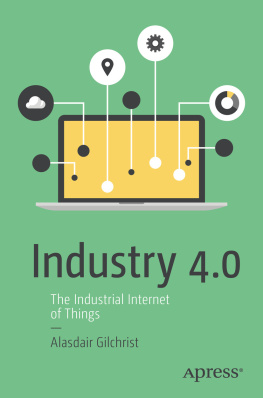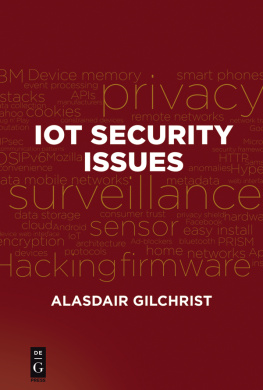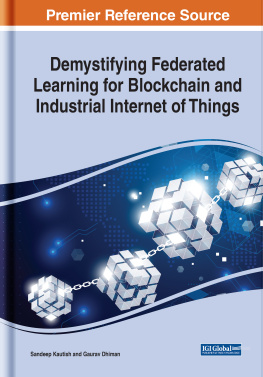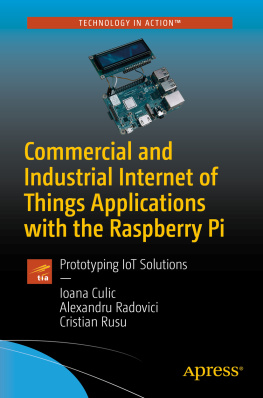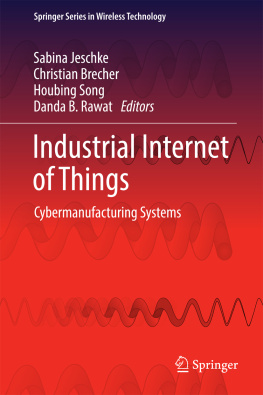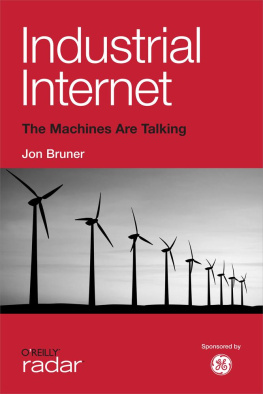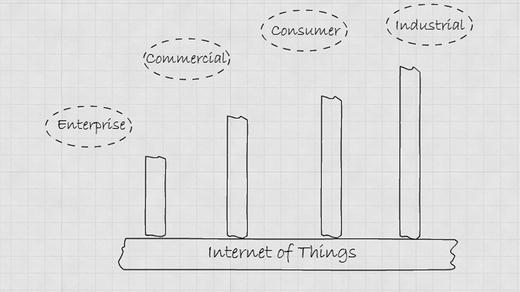1. Introduction to the Industrial Internet
GE (General Electric) coined the name Industrial Internet as their term for the Industrial Internet of Things, and others such as Cisco termed it the Internet of Everything and others called it Internet 4.0 or other variants. However, it is important to differentiate the vertical IoT strategies (see Figure ), such as the consumer, commercial, and industrial forms of the Internet from the broader horizontal concept of the Internet of Things (IoT ) , as they have very different target audiences, technical requirements, and strategies. For example, the consumer market has the highest market visibility with smart homes, personal connectivity via fitness monitors, entertainment integrated devices as well as personal in-car monitors. Similarly, the commercial market has high marketability as they have services that encompass financial and investment products such as banking, insurance, financial services, and ecommerce, which focus on consumer history, performance, and value. Enterprise IoT on the other hand is a vertical that includes small-, medium-, and large-scale businesses. However this book focuses on the largest vertical of them all, the Industrial Internet of Things, which encompasses a vast amount of disciplines such as energy production, manufacturing, agriculture, health care, retail, transportation, logistics, aviation, space travel and many more.
Figure 1-1.
Horizontal and vertical aspects of the Internet of Things
In this book to avoid confusion we will follow GEs lead and use the name Industrial Internet of Things (IIoT) as a generic term except where we are dealing with conceptually and strategically different paradigms, in which case it will be explicitly referred to by its name, such as Industry 4.0 .
Many industrial leaders forecast that the Industrial Internet will deliver unprecedented levels of growth and productivity over the next decade. Business leaders, governments, academics, and technology vendors are feverishly working together in order to try to harness and realize this huge potential.
From a financial perspective, one market research report forecasts growth of $151.01 billion U.S. by 2020, at a CAGR of 8.03% between 2015 and 2020. However, in practical terms, businesses also see that industrial growth can be realized through utilizing the potential of the Internet. An example of this is that manufacturers and governments are now seeing the opportunity to reindustrialize and bring back onshore, industry, and manufacturing, which had previously been sent abroad. By encouraging reindustrialization, governments hope to increase value-add from manufacturing to boost their GDPs.
The potential development of the Industrial Internet is not without precedence, as over the last 15 years the business-to-consumer (B2C) sector via the Internet trading in retail, media, and financial services has witnessed stellar growth. The success of B2C is evident by the dominance of web-scale giants born on the Internet, such as Amazon, Netflix, eBay, and PayPal. The hope is that the next decade will bring the same growth and success to industry, which in this context covers manufacturing, agriculture, energy, aviation, transportation, and logistics. The importance of this is undeniable as industry produces two-thirds of the global GDP, so the stakes are high.
The Industrial Internet, however, is still in its infancy. Despite the Internet being available for the last 15 years, industrial leaders have been hesitant to commit. Their hesitance is a result of them being unsure as to how it would affect existing industries, value chains, business models, workforces, and ultimately productivity and products. Furthermore, in a survey of industry business leaders, 87% claimed in January 2015 that they still did not have a clear understanding of the business models or the technologies.
This is of course to be expected as the Industrial Internet is so often described at such a high level it often decouples the complexities of the technologies that underpin it to an irrelevance. For example, in industrial businesses, they have had sensors and devices producing data to control operations for decades. Similarly, they have had machine-to-machine (M2M ) communications and collaboration for a decade at least so the core technologies of the Industrial Internet of Things are nothing new. For example, industry has also not been slow in collecting, analyzing, and hoarding vast quantities of data for historical, predictive, and prescriptive information. Therefore the question industrial business leaders often ask is, why would connecting my M2M architecture to the Internet provide me with greater value?
What Is the Industrial Internet?
To explain why businesses should adopt the Industrial Internet, we need to first consider what the IIoT actual is all about. The Industrial Internet provides a way to get better visibility and insight into the companys operations and assets through integration of machine sensors, middleware, software, and backend cloud compute and storage systems. Therefore, it provides a method of transforming business operational processes by using as feedback the results gained from interrogating large data sets through advanced analytics. The business gains are achieved through operational efficiency gains and accelerated productivity, which results in reduced unplanned downtime and optimized efficiency, and thereby profits.
Although the technologies and techniques used in existing machine-to-machine (M2M ) technologies in today's industrial environments may look similar to the IIoT, the scale of operation is vastly different. For example, with Big Data in IIoT systems, huge data streams can be analyzed online using cloud-hosted advanced analytics at wire speed. Additionally, vast quantities of data can be stored in distributed cloud storage systems for future analytics performed in batch formats. These massive batch job analytics can glean information and statistics, from data that would never previously been possible because of the relatively tiny sampling pools or simply due to more powerful or refined algorithms. Process engineers can then use the results of the analytics to optimize operations and provide the information that the executives can transform to knowledge, in order to boost productivity and efficiency and reduce operational costs.
The Power of 1%
However, an interesting point with regard to the Industrial Internet is what is termed the power of 1% . What this relates to is that operational cost/in-efficiency savings in most industries only requires Industrial Internet savings of 1% to make significant gains. For example, in aviation, the fuel savings of 1% per annum relates to saving $30 billion. Similarly, 1% fuel savings for the gas-fired generators in a power station returns operational savings of $66 billion. Furthermore, in the Oil and Gas industry, the reduction of 1% in capital spending on equipment per annum would return around $90 billion. The same holds true in the agriculture, transportation, and health care industries. Therefore, we can see that in most industries, a modest improvement of 1% would contribute significantly to the return on investment of the capital and operational expenses incurred by deploying the Industrial Internet. However, which technologies and capital expenses are required when initiating an IIoT strategy?

